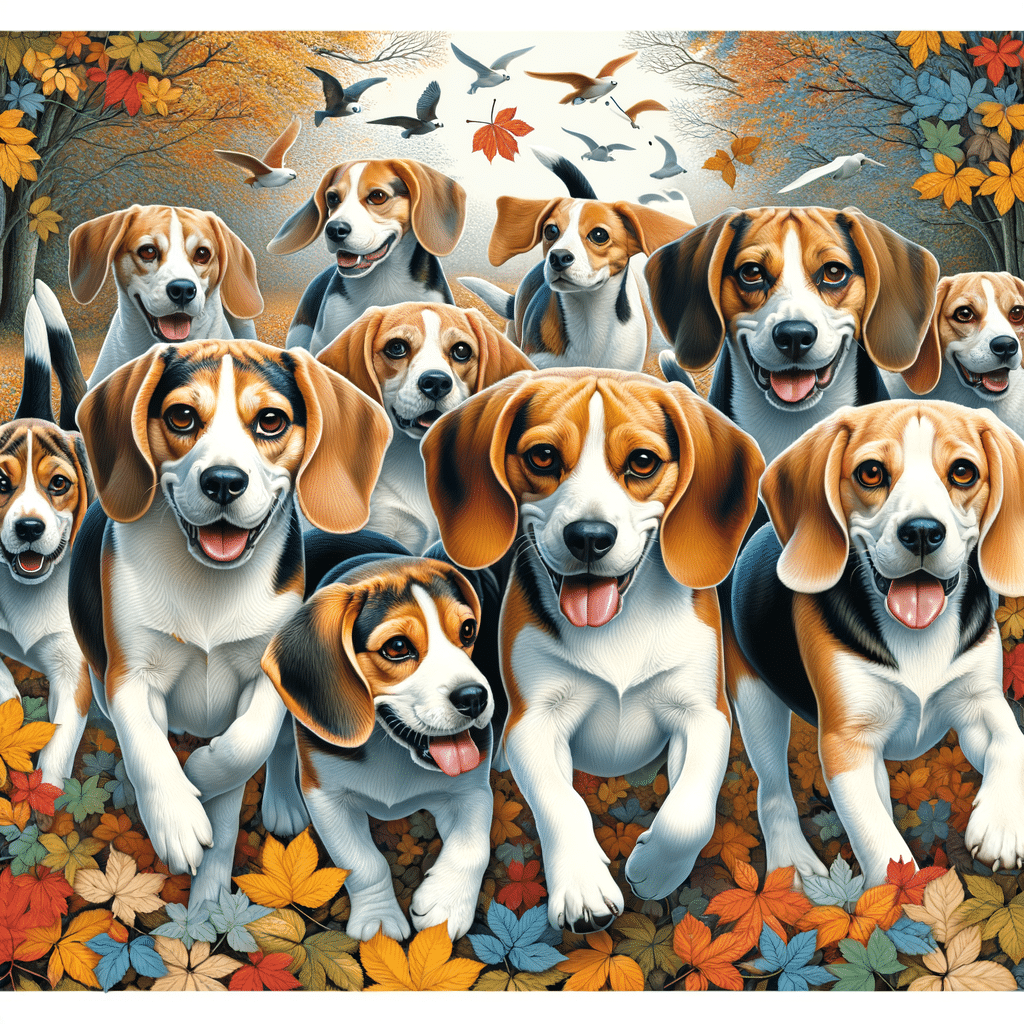Choosing a family dog requires careful consideration to find the perfect match. When it comes to the beagle vs. rat terrier, making the right choice often involves studying the unique characteristics of each breed. As a potential owner, you should weigh factors like size, temperament, and maintenance to ensure the right fit for your household.
In This Article
Beagles, known for their keen sense of smell and tracking abilities, are small- to medium-sized hounds with affable personalities. They make excellent companions, especially for families. Rat terriers, conversely, are small- to medium-sized dogs known for their intelligence and lively temperament. They were initially bred for farm work and hunting vermin.
While the beagle and rat terrier can be excellent choices for new or inexperienced owners, their distinct traits set them apart. The beagle typically shows a gentle and friendly nature, making it an excellent pet for children.
The rat terrier’s playful spirit produces a high-energy companion well-suited for an active lifestyle. Both breeds are low-maintenance when it comes to grooming. However, their care routines may vary due to their different coats and potential health concerns. Understanding each breed’s individual characteristics and needs is crucial for you as an owner.
Highlights
- Beagles and rat terriers are popular dog breeds that would suit new owners, but they differ in personality and energy levels.
- Low maintenance grooming needs for both breeds, with specific attention to their distinct coats.
- Properly understanding each breed’s characteristics ensures a compatible match for families.
Breed Origins and History
The beagle and rat terrier breeds have rich histories, each originating from different countries and serving distinct purposes. The beagle, known for its hunting prowess, originated in England, while the rat terrier developed in the United States as a skilled farm and hunting companion.
Beagle Origins
The beagle is one of the oldest dog breeds, and its roots are in England. Evidence of beagle-like dogs dates back to Roman times, but the modern breed was developed in the 1830s from various hound breeds, including the Harrier and other English hounds. The beagle was bred primarily for hunting small game, especially rabbits and hares.
Rat Terrier Evolution
The rat terrier began in the United States in the early 20th century. This breed is an efficient ratter and farm dog, which involved cross-breeding the smooth fox terrier with other breeds like the Manchester terrier, whippet, and even the beagle itself. The rat terrier was recognized and valued for its versatility, quick reflexes, and tenacious hunting abilities on American farms.
Physical Characteristics
When comparing the beagle and rat terrier breeds, it’s notable that they display distinct physical characteristics, largely in size, weight, and recognizable features. These aspects distinctly influence each breed’s appearance and grooming requirements.
Comparing Size and Weight
Beagle
- Size: Classified as a small dog to medium-sized dog.
- Weight: Adult beagles typically weigh between 20 to 30 pounds (9 to 13.5 kg).
- Standard: They commonly stand about 13 to 15 inches (33 to 38 cm) tall at the shoulder.
Rat Terrier
- Size: Generally small-sized, but can vary.
- Weight: Rat terriers can weigh from 10 to 25 pounds (4.5 to 11.3 kg), depending on the subtype of the terrier group.
- Standard: Their height ranges from about 10 to 18 inches (25 to 45 cm) at the shoulder as an adult, while the rat terrier puppy is significantly smaller.
Distinctive Features
Beagle
- Colors: Beagle dogs sport various coat colors, including tricolor, red, white, and lemon.
- Ears: Beagles are known for their large, floppy ears.
- Coat: They possess a short, weather-resistant coat.
Rat Terrier
- Colors: A rat terrier’s coat can include variations such as black, chocolate, tan, and gray, and sometimes solid colors like white. It often features a mix of colors, including tri-color patterns.
- Ears: Unlike the beagle, rat terriers usually have erect, triangular ears, although they can also be tipped or buttoned.
- Coat: They have a short, single coat that is smooth.
Temperament and Personality
When comparing the beagle with the rat terrier, distinctive traits define their temperaments and personalities. The beagle typically demonstrates a friendly and affectionate nature, while the rat terrier often shows a blend of intelligence and independence.
Behavioral Traits
Beagle
- Friendly: Beagles are generally outgoing and amiable with people and other pets.
- Intelligent: They are clever but can be stubborn regarding training.
Rat Terrier
- Independent: Rat terriers display an independent streak yet are still eager to please their owners.
- Playful: They tend to be very playful and enjoy engaging in activities, especially games involving chasing.
Pet Compatibility
Beagle
- Children: Known for being kid-friendly, beagles usually integrate well with family life.
- Other pets: They are largely pet-friendly, often getting along with other dogs if correctly socialized.
Rat Terrier
- Stranger-friendly: Initially wary around strangers, rat terriers can warm up to be quite affectionate and loving.
- Barking: While they can be more reserved, they may also be predisposed to bark more, which is a part of their alert temperament.
Health and Care
In considering the beagle and the rat terrier, it is essential to understand their respective dog health challenges and care needs. Each breed requires specific attention to exercise, diet, and grooming to promote a healthy life.
Common Health Issues
Both beagles and rat terriers are generally healthy but can be predisposed to certain health problems. According to the American Kennel Club, beagles may present issues such as hip dysplasia, epilepsy, cherry eye, glaucoma, hypothyroidism, and beagle dwarfism. Rat terriers, on the other hand, could face patellar luxation, hip dysplasia, heart problems, and allergies. Consider buying pet insurance to guard against these potential issues.
- Hip dysplasia: A malformation of the hip joint that can cause pain and arthritis
- Epilepsy: A neurological disorder that can lead to seizures
- Cherry eye: A prolapse of the third eyelid gland requiring surgical correction
- Glaucoma: Increased eye pressure causing pain and potentially leading to blindness
- Hypothyroidism: An underactive thyroid gland that can lead to obesity and other issues
Exercise and Nutrition
The energetic nature of beagles and rat terriers demands ample exercise to maintain a healthy weight and prevent obesity. A combination of physical activities and mental stimulation is ideal for these breeds.
- Beagles: Require daily walks and interactive play; prone to obesity if not exercised regularly.
- Rat terriers: Have a high energy level and benefit from varied activities such as agility training.
Diet is equally important and must be tailored to the dog’s size, age, and activity level. Both breeds should eat high-quality dog food and treats in moderation.
Grooming and Maintenance
Regular grooming is vital for beagles and rat terriers, not only for cleanliness but also to monitor their health. Beagles have a short, dense double coat that sheds moderately, and rat terriers have a smooth, single coat with minimal shedding.
Beagles
- Weekly brushing to reduce shedding
- Regular ear checks to prevent infections due to their floppy ears
Rat Terriers
- Low maintenance, occasional brushing due to minimal shedding
- Periodic ear cleaning and nail trimming as required
Both breeds should have their teeth brushed regularly to prevent dental issues, which could lead to more serious health problems if left unattended.
Frequently Asked Questions
This section addresses some of the most common inquiries regarding the differences and characteristics of beagles and rat terriers, including an insight into their mixed breed.
What are the distinct temperamental differences between a beagle and a rat terrier?
Beagles are known for their friendly and curious nature, which makes them excellent with children. In contrast, rat terriers are intelligent and a bit wary of strangers but also loyal and loving companions.
How do the sizes of beagles and rat terriers compare?
Beagles generally weigh between 20 and 30 pounds and stand about 13 to 15 inches tall at the shoulder. In comparison, rat terriers typically range between 10 and 25 pounds and stand 10 to 18 inches tall, with some variances depending on the type of rat terrier.
Can you describe the temperament of a beagle-rat terrier mix?
A beagle-rat terrier mix, or raggle, is likely to be energetic, intelligent, and willful but also affectionate and alert. This mix combines beagles’ playful nature with rat terriers’ alertness and energy.
Which breeds were crossed to develop the rat terrier?
The rat terrier was developed using a mix of breeds, including the smooth fox terrier, the Manchester terrier, and other types of terriers, with possible contributions from beagles, whippets, and Italian greyhounds.
Are rat terriers typically affectionate, and do they enjoy cuddling?
Rat terriers are generally affectionate with their family members and can enjoy cuddling, although they also have a strong independent streak and may sometimes seek time alone.
Is excessive barking a typical behavior in rat terriers?
Rat terriers may bark to alert their owners of someone’s approach but are not known for excessive barking. However, like any dog, individual behavior can vary, and some may bark more than others based on the environment and training.






